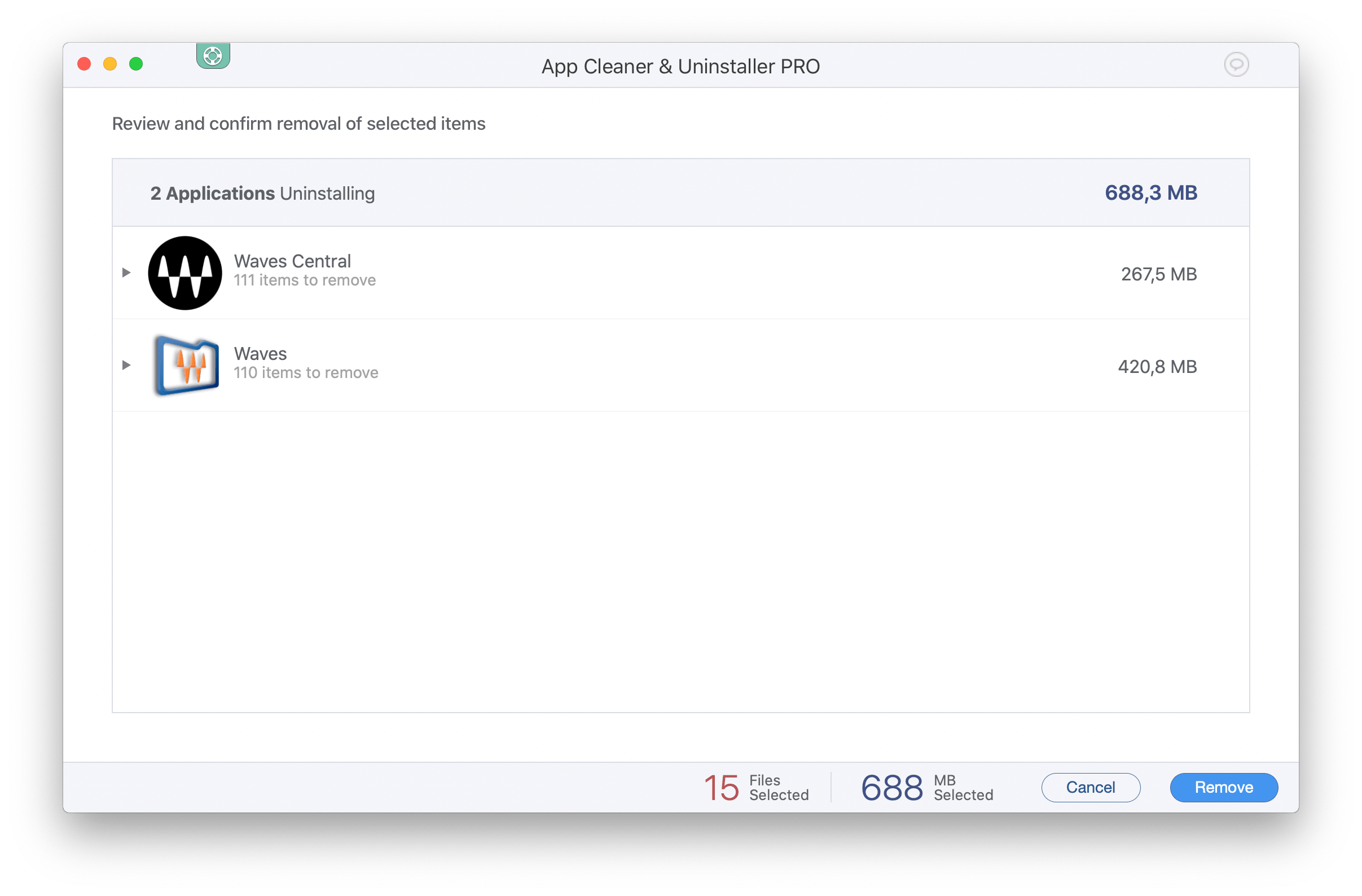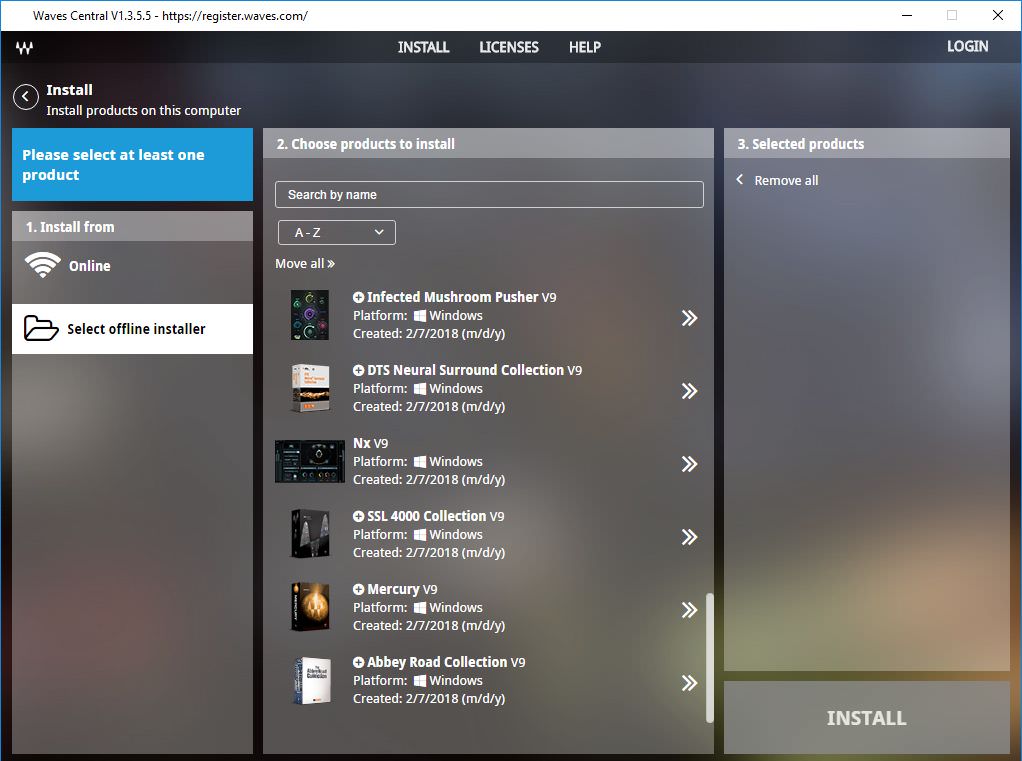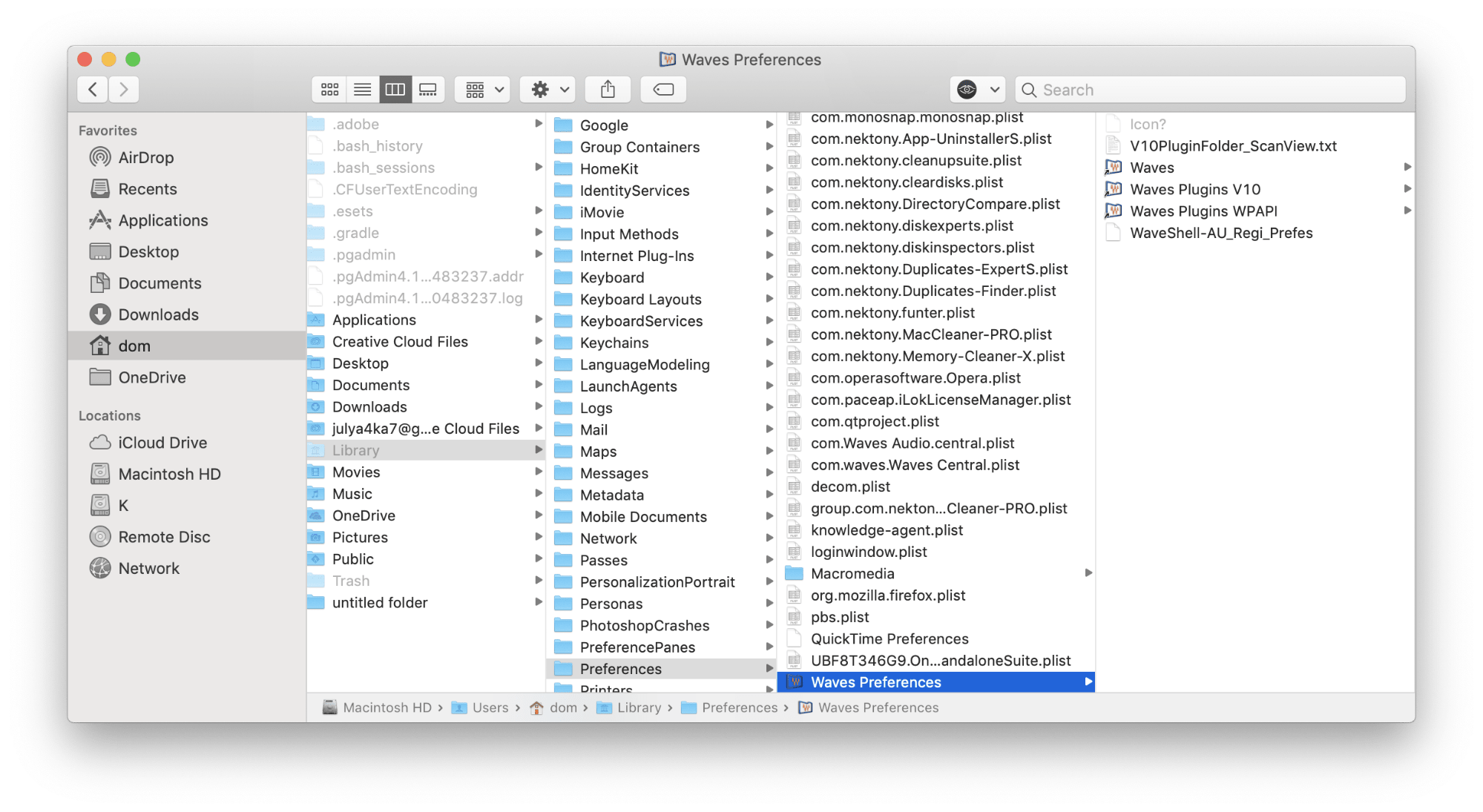- Most of the time, uninstalling is this simple: Exit the program you want to delete. Open the Applications folder, which you'll find by opening a new window in the Finder, or clicking on the hard disk icon. Drag the icon of the program you want to uninstall to the Trash.
- Advanced Uninstaller PRO will remove Waves Complete V9r26. After uninstalling Waves Complete V9r26, Advanced Uninstaller PRO will ask you to run an additional cleanup. Press Next to proceed with the cleanup. All the items that belong Waves Complete V9r26 that have been left behind will be detected and you will be able to delete them.
- Waves Complete 2019 Mac torrent is used by a lot of people who are into music production, DJ, and audio mixing. If you are familiar with WUP then, then you probably here to download Waves plugin torrent. Waves Complete v10 full Collection offers more effects, more channel components, more mixdown tools, more processors than ever before in one.
(It can be in a folder inside your mac like Documents or an external hard drive) 2- RUN “DELETE WAVES” 3- Reboot 4- RUN “Waves 11 Complete NO INST ALL.pkg ” 5- Click Done, Accept and Finish in the REGUTILE 6- Done 7- Reboot IMPORTANT!! After all the steps 9-OPEN “System Preferences” – Users and groups –. Choose “Login Items.
Weather Forecast removal instructions
What is Weather Forecast?
Weather Forecast is a rogue application claiming to install a desktop widget that enables users to observe current weather forecasts. On initial inspection, this may seem legitimate and useful functionality, however, be aware that Weather Forecast is categorized as adware or a potentially unwanted program (PUP). The developers of this PUP employ a deceptive software marketing method called 'bundling' to install on computers without users' consent. Bundling is a way to stealthily distribute applications together with other software, and therefore, most users inadvertently install Weather Forecast during download of free software on freeware download websites. After successful infiltration on Internet Explorer, Mozilla Firefox, and Google Chrome, Weather Forecast generates intrusive online advertisements and tracks users' Internet browsing activity.
The list of advertisements generated by this rogue application include (but is not limited to) banner, pop-up, and in-text ads. There is a high probability that clicking these advertisements will lead to further adware or malware infections. Furthermore, Weather Forecast continually monitors users' Internet browsing activity by collecting various software and hardware information such as IP addresses (to determine users' geographic locations), browser types, website URLs visited, search queries entered into search engines (Google, Yahoo, Bing, etc.), pages viewed, cookies, and other similar details that are likely to be personally identifiable. This information tracking may lead to serious privacy issues or identity theft, and therefore, you are strongly advised to uninstall Weather Forecast from your system.
Weather Forecast is similar to other PUPs that use bundling as an installation method. Some examples include Desktop Temperature Monitor, LookThisUp, KNCTR, and Web Bar among many others. These applications are useless to the user - their purpose is to generate revenue by the display of intrusive online ads, enforcing unwanted browser redirects, and sharing collected information with third parties. Research shows that most adware is distributed via small programs called 'download managers' on freeware download websites such as soft32.com, download.com, softonic.com. Download managers are employed by these websites as free service and traffic monetization tools, since they offer installation of promoted '100% virus-free' applications together with the chosen free software. Thus, reckless download and installation of freeware often leads to adware or malware infections. This situation can be prevented by closely studying each step of the free. software download procedure and clicking 'Decline' if installation of any additional applications is offered. Furthermore, all software downloaded from the Internet should be installed using the 'Custom' or 'Advanced' installation options, rather than 'Quick' or 'Typical' - this will reveal any bundled applications listed for installation and allow you to opt-out. If you have already installed Weather Forecast, and observe intrusive online advertisements when surfing the Internet, follow the removal instructions provided to eliminate this adware from your computer.
Weather Forecast desktop widget:
Weather Forecast adware installer:
Instant automatic malware removal:Manual threat removal might be a lengthy and complicated process that requires advanced computer skills. Malwarebytes is a professional automatic malware removal tool that is recommended to get rid of malware. Download it by clicking the button below:
▼ DOWNLOAD MalwarebytesBy downloading any software listed on this website you agree to our Privacy Policy and Terms of Use. To use full-featured product, you have to purchase a license for Malwarebytes. 14 days free trial available.
Quick menu:
- STEP 1. Uninstall Weather Forecast application using Control Panel.
- STEP 2. Remove Weather Forecast related adware from Internet Explorer.
- STEP 3. Remove Weather Forecast bundled adware from Google Chrome.
- STEP 4. Remove Weather Forecast related plugins from Mozilla Firefox.
- STEP 5. Remove Weather Forecast extension from Safari.
- STEP 6. Remove rogue plug-ins from Microsoft Edge.
Weather Forecast adware removal:
Windows 7 users:
Click Start (Windows Logo at the bottom left corner of your desktop), choose Control Panel. Locate Programs and click Uninstall a program.
Windows XP users:
Click Start, choose Settings and click Control Panel. Locate and click Add or Remove Programs.
Windows 10 and Windows 8 users:
Right-click in the lower left corner of the screen, in the Quick Access Menu select Control Panel. In the opened window choose Programs and Features.

Mac OSX users:
Click Finder, in the opened screen select Applications. Drag the app from the Applications folder to the Trash (located in your Dock), then right click the Trash icon and select Empty Trash.
In the uninstall programs window, look for 'Weather Forecast', select this entry and click 'Uninstall' or 'Remove'.
After uninstalling the potentially unwanted program (which causes Weather Forecast ads), scan your computer for any remaining unwanted components or possible malware infections. To scan your computer, use recommended malware removal software.
Malwarebytes checks if your computer is infected with malware. To use full-featured product, you have to purchase a license for Malwarebytes. 14 days free trial available.
Remove Weather Forecast adware from Internet browsers:
At time of research, Weather Forecast installed no browser plug-ins on Internet Explorer, Google Chrome, or Mozilla Firefox, however, it was bundled with other adware. Therefore, you are advised to remove all potentially unwanted browser add-ons from your Internet browsers.
Video showing how to remove potentially unwanted browser add-ons:
Remove malicious add-ons from Internet Explorer:
Click the 'gears' icon (at the top right corner of Internet Explorer), select 'Manage Add-ons'. Look for any recently-installed suspicious browser extensions, select these entries and click 'Remove'.
Optional method:
If you continue to have problems with removal of the weather forecast desktop widget, reset your Internet Explorer settings to default.
Windows XP users: Click Start, click Run, in the opened window type inetcpl.cpl In the opened window click the Advanced tab, then click Reset.

Windows Vista and Windows 7 users: Click the Windows logo, in the start search box type inetcpl.cpl and click enter. In the opened window click the Advanced tab, then click Reset.
Windows 8 users: Open Internet Explorer and click the gear icon. Select Internet Options.
In the opened window, select the Advanced tab.


Click the Reset button.
Confirm that you wish to reset Internet Explorer settings to default by clicking the Reset button.
Remove malicious extensions from Google Chrome:
Click the Chrome menu icon (at the top right corner of Google Chrome), select 'Tools' and click on 'Extensions'. Locate any recently-installed suspicious add-ons, select these entries and click the trash can icon.
Optional method:
If you continue to have problems with removal of the weather forecast desktop widget, reset your Google Chrome browser settings. Click the Chrome menu icon (at the top right corner of Google Chrome) and select Settings. Scroll down to the bottom of the screen. Click the Advanced… link.
After scrolling to the bottom of the screen, click the Reset (Restore settings to their original defaults) button.
In the opened window, confirm that you wish to reset Google Chrome settings to default by clicking the Reset button.
Remove malicious plugins from Mozilla Firefox:
Click the Firefox menu (at the top right corner of the main window), select 'Add-ons'. Click on 'Extensions', in the opened window, remove any recently-installed suspicious browser plug-ins.
Optional method:
Computer users who have problems with weather forecast desktop widget removal can reset their Mozilla Firefox settings.
Open Mozilla Firefox, at the top right corner of the main window, click the Firefox menu, in the opened menu, click Help.
Select Troubleshooting Information.
In the opened window, click the Refresh Firefox button.
In the opened window, confirm that you wish to reset Mozilla Firefox settings to default by clicking the Refresh Firefox button.
Remove malicious extensions from Safari:
Make sure your Safari browser is active, click Safari menu, and select Preferences...
In the opened window click Extensions, locate any recently installed suspicious extension, select it and click Uninstall.
Optional method:
Make sure your Safari browser is active and click on Safari menu. From the drop down menu select Clear History and Website Data..
In the opened window select all history and click the Clear History button.
Remove malicious extensions from Microsoft Edge:
Click the Edge menu icon (at the upper-right corner of Microsoft Edge), select 'Extensions'. Locate all recently-installed suspicious browser add-ons and click 'Remove' below their names.
Optional method:
If you continue to have problems with removal of the weather forecast desktop widget, reset your Microsoft Edge browser settings. Click the Edge menu icon (at the top right corner of Microsoft Edge) and select Settings.
A video guide to finding, removing and then refitting the battery in a Citroen Xsara Picasso. Hope it helps in some way. Xsara picasso battery removal.
In the opened settings menu select Reset settings.

Mac Uninstall Chrome
Select Restore settings to their default values. In the opened window, confirm that you wish to reset Microsoft Edge settings to default by clicking the Reset button.
- If this did not help, follow these alternative instructions explaining how to reset the Microsoft Edge browser.
Manually Uninstall Waves Plugins Mac
Summary:
Commonly, adware or potentially unwanted applications infiltrate Internet browsers through free. software downloads. Note that the safest source for downloading free software is via developers' websites only. To avoid installation of adware, be very attentive when downloading and installing free software. When installing previously-downloaded free programs, choose the custom or advanced installation options – this step will reveal any potentially unwanted applications listed for installation together with your chosen free program.
Removal assistance:
If you are experiencing problems while trying to remove weather forecast desktop widget from your computer, please ask for assistance in our malware support forum.
Uninstall Waves Plug-ins On Mac
Post a comment:
If you have additional information on weather forecast desktop widget or it's removal please share your knowledge in the comments section below.

